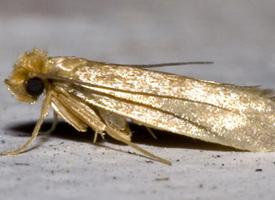
State of endangerment
| Non Endangered |
Animal description
The Common Clothes Moth, scientifically known as Tineola bisselliella, is a small but widely recognized pest that has gained notoriety for its damaging effects on clothing, carpets, and various fabric materials. This moth species is part of the Tineidae family, which includes several similar fabric-eating moths. Despite its diminutive size, the common clothes moth plays a significant role in household and museum pest management challenges.Adult common clothes moths have a wingspan of approximately 14 to 18 millimeters. Their forewings are a light, golden color with a subtle, shiny lustre, and their hind wings are a lighter, greyish hue. Unlike other moths that are attracted to light, Tineola bisselliella adults are actually photophobic, meaning they avoid light sources. This behavior makes them more likely to be found in dark, undisturbed areas such as closets, attics, and storage boxes, where they can lay their eggs in peace.
The real damage to fabrics is not actually caused by the adult moths but by their larvae. Female moths lay tiny, almost invisible eggs on materials that can serve as food sources for the larvae. These materials include natural fibers such as wool, silk, feathers, and fur. Synthetic fibers are not immune, especially if they are blended with natural fibers or are soiled with food stains, sweat, or oils. After the eggs hatch, the larvae begin to feed, creating irregular holes and damaging the integrity of the material. The larvae are creamy white caterpillars with a brown head, and they can grow up to 10 millimeters in length. They spin silken tunnels or mats on the surface of the material they are consuming, further indicating an infestation.
The lifecycle of the common clothes moth depends on environmental conditions, with temperature and humidity playing critical roles. In ideal conditions, the lifecycle from egg to adult can be as short as two months, but in less favorable conditions, it can take up to two years. This variability in lifecycle length contributes to the difficulty in controlling and eradicating infestations once they have begun.
Control and prevention of common clothes moth infestations involve a combination of cleaning, vigilance, and, when necessary, chemical treatments. Regular cleaning and vacuuming of at-risk areas can help remove eggs and larvae from the environment. Storing clothes and fabrics in airtight containers can prevent moths from laying eggs on them. Mothballs, lavender sachets, and cedar wood are traditional repellents, although their effectiveness can vary. In severe cases, professional pest control services may be necessary to fully eradicate an infestation.
Despite their small size and unassuming appearance, common clothes moths pose a significant threat to textiles and require careful management to prevent damage. Their lifecycle and behaviors have been well-studied, allowing homeowners and conservators alike to implement strategies to protect valuable fabric items from these hungry pests.
New photos of animals
Top 10 animals
- Dolphin gull (Leucophaeus scoresbii)
- Diana monkey (Cercopithecus diana)
- Moustached guenon (Cercopithecus cephus)
- Galápagos tortoise (Geochelone nigra complex)
- Japanese macaque (Macaca fuscata)
- Stone loach (Barbatula barbatula)
- Russian tortoise (Testudo horsfieldii)
- Greek tortoise (Testudo graeca)
- Common flying dragon (Draco volans)
- Vendace (Coregonus albula)